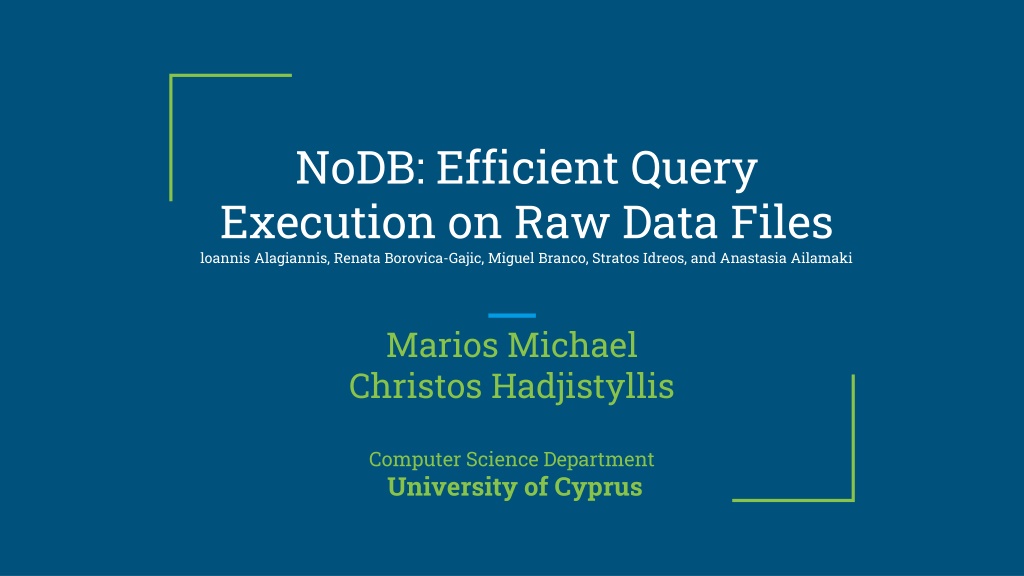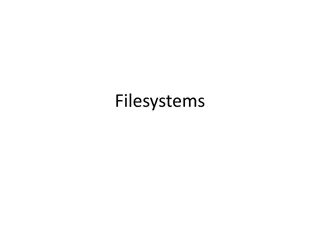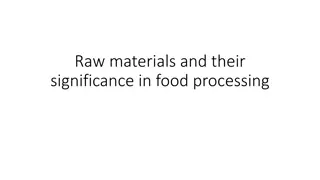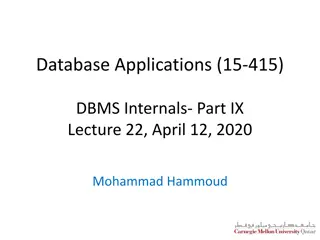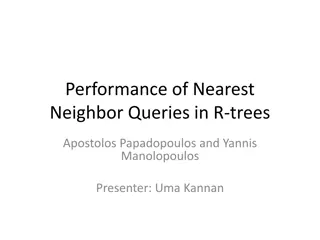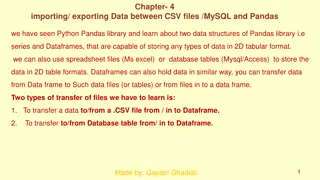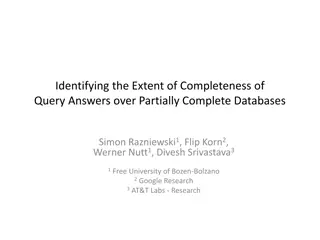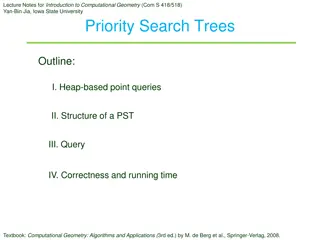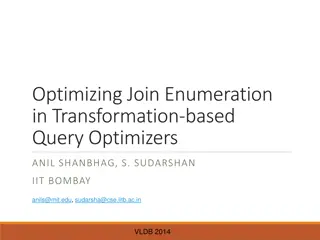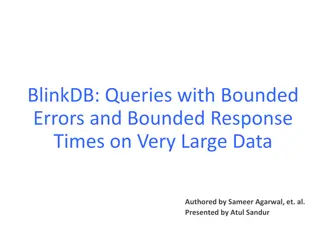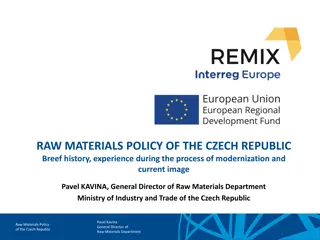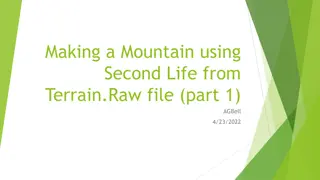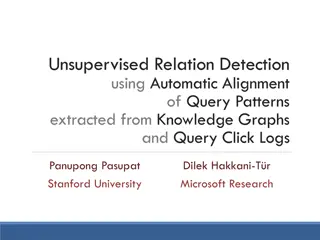Efficient Query Execution on Raw Data Files
This research explores NoDB, a database system designed to eliminate the bottleneck of data-to-query time by querying raw data files in their original location. By redesigning the query processing layer to query raw data in situ state while automatically creating auxiliary structures, NoDB aims to make database systems more accessible to users. Traditional DBMS processes involve loading data and preparing the system for queries, but NoDB seeks to streamline this process. The study compares the approaches of running loading procedures when a query arrives versus integrating raw file accesses with query execution. Limitations include challenges with extensive and repeated query processing.
Download Presentation

Please find below an Image/Link to download the presentation.
The content on the website is provided AS IS for your information and personal use only. It may not be sold, licensed, or shared on other websites without obtaining consent from the author.If you encounter any issues during the download, it is possible that the publisher has removed the file from their server.
You are allowed to download the files provided on this website for personal or commercial use, subject to the condition that they are used lawfully. All files are the property of their respective owners.
The content on the website is provided AS IS for your information and personal use only. It may not be sold, licensed, or shared on other websites without obtaining consent from the author.
E N D
Presentation Transcript
NoDB: Efficient Query Execution on Raw Data Files loannis Alagiannis, Renata Borovica-Gajic, Miguel Branco, Stratos Idreos, and Anastasia Ailamaki Marios Michael Christos Hadjistyllis Computer Science Department University of Cyprus
Introduction DBMS: Complexity (Significant initialization cost in loading data and preparing database system for queries) Goal of NoDB: Make a database system which is more accessible to the user by eliminating major bottleneck of data-to-query time Main Idea: Eliminating data loading by: Querying over raw data in original place as the way to manage data in a database Redesign query processing layer to incrementally and adaptively query raw data in situ state (original place) while automatically creating and refining auxiliary structures to speed-up future queries 2
Introduction - Traditional DBMS Organizes data as a row store system, in the form of tuples, which are stored sequentially one tuple after the other in the form of slotted pages + additional metadata information to help in-page navigation Creation of DB objects during loading process During query processing the system brings pages into memory and process the tuples Optimizer: Creation of proper query plans, which exploit previously collected statistics about the data 3
Query over raw data files Two straightforward ways: Run the loading procedure whenever a query arrives When a query referring to table R arrives, only then load table R, and immediately evaluate the query over the loaded data The above approaches penalize the first query since creating the complete table before evaluating the query implies that the same data needs to be accessed twice Once for loading Once for query evaluation 4
Query over raw data files Tightly integrate the raw file accesses with the query execution It can be accomplished by enriching the leaf operators of the query plans with the ability to access raw data files The scan operator tokenizes and parses a raw file on-the-fly, which allows it to create and pass tuples to the remaining query plan Data parsing and processing occur in a pipeline Limitations Not viable for extensive and repeated query processing E.g: If data is not kept in persistent tables, then every future query needs to perform loading from scratch Materializing loaded data into persistent tables, forces a single query to adapt all loading costs 5
NoDB Philosophy Minimize loading costs, while achieving or improving the query processing performance of a traditional DBMS Individual queries may take longer to respond, than in traditional system, BUT Data-to-query time is reduced because there is no need to load and prepare data in advance or to tune the system when different queries arrive PERFORMANCE IMPROVES GRADUALLY AS A FUNCTION OF THE NUMBER OF QUERIES PROCESSED 6
Challenges Main Bottleneck of in situ query processing is the access of the raw data Degrades significantly the query performance NoDB: Integrating raw data access in an abstract way into the query processing layer Main challenge: Minimize the cost of accessing raw data. Two ways: Design data structures which can help up speed-up the access Selectively eliminating the need of raw data access by caching and scheduling raw data accesses 7
Postgresraw: Building NoDB in Postgresql Assuming the the raw data is stored in comma separated values (CSV files) High conversion cost to binary format (challenge for situ states) On the fly parsing: When a query submitted to postgresraw reference relational tables that are not yet loaded, postgresraw needs to access the respective raw files It overrides the scan operator with the ability to access raw data files directly Parsing and Tokenizing every time a query need to access raw data CSV File: File = Relational Table Row = A Tuple of a Table Entry = Attributed value of a Tuple 8
Postgresraw: Building NoDB in Postgresql During parsing: Identify each tuple or row in the raw file Once they are identified, search for a delimiter separating values and transform those characters into proper binary values Selective Tokenizing: Reduce the tokenizing cost by opportunistically abort tokenizing tuples as soon as the required attributes for a query have been found CSV is row-row so we can reduce CPU processing costs Selective Parsing: Reduce raw access cost Transform to binary format only the values that are required to answer the query 9
Postgresraw: Building NoDB in Postgresql Selective Tuple Formation: Tuples contain only the attributes required for a given query They are created only after select operator RESULT: SIGNIFICANTLY MINIMIZE ON THE FLY PROCESSING COST 10
Postgresraw: Building NoDB in Postgresql Indexing Adaptive Positional Map Reduces parsing and tokenizing costs Maintains low level metadata information on the structure of the flat file Metadata refers to position of attributes in a raw file Use metadata to navigate and retrieve raw data faster Info of positional map can be used to jump to the exact position of the file or as close as possible E.g: if a query is looking for the 9th attribute of a file, while the map contains info for the 4th and 8th attribute it will parse it until it will find it 11
Postgresraw: Building NoDB in Postgresql Map Population Created on the fly, during query processing Depending on where the requested attributes are located on the current map Continuously adapting to queries Is populated during the tokenizing phase, while tokenizing the raw file for the current query Information also added to the map, so that Postgresraw can learn as much information as possible during each query 12
Postgresraw: Building NoDB in Postgresql Positional Map -Storage Format Requires a physical organization that is easy to update and incurs low cost during query execution It is implemented as a collection of chunks that fit comfortably in the CPU cache, allowing Postgres to acquire all required data with a single access It can also be extended by adding more chunks either vertically or horizontally Attributes that do not necessarily appear in the map In the same order as the raw file 13
Postgresraw: Building NoDB in Postgresql Positional Map -Maintenance Auxiliary structure and may be dropped fully or partly without any loss of critical information Every next query starts rebuilding the map from scratch Postgres assign a storage threshold for the size of positional map such that the map fits comfortably in memory Positional Map -Adaptive Behavior Continuously indexes positions based on the most recent queries Least recently used policy -Dropping attributes which may no longer be relevant Combinations of attributes used in the same query, which are stored together may be dropped to give space to new combinations 14
Postgresraw: Building NoDB in Postgresql Cache Caching Avoid raw file access together If the attribute is requested by future queries, then it will be read directly from cache Holds binary data -no need for additional parsing Populated on-the-fly during query processing Follows format of positional map to allowing queries to seamlessly exploit both the cache and the positional map in the same query plan 15
Postgresraw: Building NoDB in Postgresql Optimizer Extension of Postgres scan operator in order to create statistics on-the-fly Invoke native statistics routines of DBMS, providing it with a sample of the data Statistics stored and exploited in the same way as in conventional DBMS Postgresraw creates statistics only on requested attributes in order to minimize the overhead of creating statistics query processing 16
Experimental evaluation: Environment Sun X4140 server 2 Quad-Core AMD Opteron processor (64 bit) 2.7 GHz with 512KB L1 cache, 2MB L2 cache and 6MB L3 cache 32GB RAM 4 250GB 10,000 RPM SATA disks (RAID-0) Ubuntu 9.04 11GB raw file 7.5 million tuples Each tuple contains 150 attributes with random integers [0 109) 17
Experimental evaluation: Positional map impact Each query asks for 10 random attributes and retrieves all the rows of the file Measure the average time PostgresRaw needs to process all queries varying storage capacity for positional map from 14.3MB up to 2.1GB 18
Experimental evaluation: Positional map scalability File size is increased gradually from 2GB to 92GB Two types of tests Adding more rows to the file (vertical) query incrementally more attributes Adding more attributes to the file (horizontal) query all rows and 10 random attributes each time Unlimited storage space for the positional map Store only positions accessed by the most recent queries in map Exhibits linear scalability: PostgresRaw exploits the positional map to scale as raw files grow both vertically and horizontally 19
Experimental evaluation: Positional map + Caching 50 queries, each query randomly accesses five columns and all rows Four variations of test Baseline -no positional maps or caching used PM -only positional map is used C -only caching used PM+C -Both PS and caching used 21
Experimental evaluation: Adapting to workload changes Demonstrate that PostgresRaw progressively and transparently adapts to changes in the workload 250 queries -50 different queries x 5 epochs (time instances) Each epoch focuses on a given part of the raw file 5 random attributes in each query Cache is limited to 2.8GB, positional map to 715MB 23
Experimental evaluation: PostgresRaw vs DBMS MySQL (5.5.13), DBMS X (a commercial system) and PostgreSQL PostgresRaw with positional maps and caching enabled MySQL and DBMS X offer external files functionality Test with pre-loaded data in DBMS s (without external files functionality) Test with external files functionality Q1: all attributes and all rows Q2, Q3, Q4, Q5: access 20%, 40%, 60%, 80% less rows respectively Q6, Q7, Q8, Q9: access 20%, 40%, 60%, 80% less columns (attributes) respectively 25
Experimental evaluation: on-the-fly statistics Four instances of TPC-H decision support benchmark Query 1 Two tests: With on-the-fly statistics & No statistics at all 28
TPC-H decision support benchmark Query 1 SELECT L_RETURNFLAG, L_LINESTATUS, SUM(L_QUANTITY) AS SUM_QTY, SUM(L_EXTENDEDPRICE) AS SUM_BASE_PRICE, SUM(L_EXTENDEDPRICE*(1-L_DISCOUNT)) AS SUM_DISC_PRICE, SUM(L_EXTENDEDPRICE*(1-L_DISCOUNT)*(1+L_TAX)) AS SUM_CHARGE, AVG(L_QUANTITY) AS AVG_QTY, AVG(L_EXTENDEDPRICE) AS AVG_PRICE, AVG(L_DISCOUNT) AS AVG_DISC, COUNT(*) AS COUNT_ORDER FROM LINEITEM WHERE L_SHIPDATE <= dateadd(dd, -90, cast('1998-12-01' as date)) GROUP BY L_RETURNFLAG, L_LINESTATUS ORDER BY L_RETURNFLAG,L_LINESTATUS 29
NoDB (In Situ Querying) trade-offs (1) Data type conversion: overhead to convert strings to binary BUT PostgresRaw only converts attributes needed minimizing overhead File size versus database size: data loading an overhead, BUT binary storage (usually) takes less space on disk than raw text files Complex database schemas: DBMS can support complex relations with a lot of tables, rows and columns Types of data analysis: NoDB querying best for exploring subsets of large datasets, DBMS best for data loaded rarely in an incremental fashion with well-known workloads 30
NoDB (In Situ Querying) trade-offs (2) Integration with external tools: ODBC, stored procedures and user-defined functions in DBMS BUT NoDB files can be used by legacy code parallel to NoDB query engine Database independence: using raw data files means data ownership stays with user not DBMS developer who uses proprietary data pages formats 31
NoDB Opportunities Flexible storage: no need to worry on how data is physically organized during data loading, easier to adapt to workload later Adaptive indexing: building and refining indexes without DBA or knowing the workload Auto-tuning tools: exploiting idle time or workload knowledge to load and index data Information integration: easy to develop plugins to handle different raw data file formats File system interface: NoDB data is stored in file systems (NTFS, ext4) can intercept file system calls and create auxiliary data structures to speed-up future queries 32
Conclusions For state-of-the-art database systems, the incoming data flood is a problem Drastic changes to existing query processing technology eliminates data loading overhead/bottleneck NoDB prototype system, PostgresRaw, demonstrates competitive performance with DBMS Does not require any previous assumptions about data to load or how to load it before querying Allows users to explore new data quickly Challenges exist but more research is underway 33
Thank you for your attention! 34
